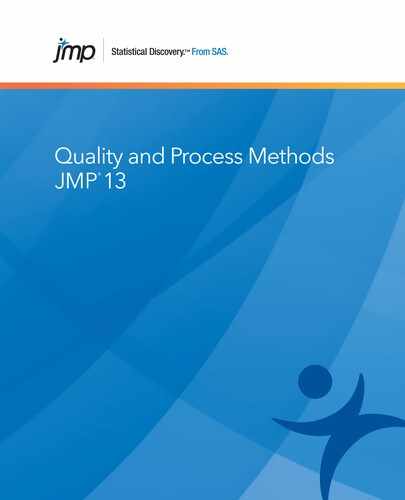Introduction to Quality and Process Methods
Tools for Process and Product Improvement
This book describes a number of methods and tools that are available in JMP to help you evaluate and improve quality and process performance:
• Control charts provide feedback on key variables and show when a process is in, or out of, statistical control. Chapter 3, “Control Chart Builder” and Chapter 4, “Shewhart Control Charts” describe the JMP approach to creating control charts, including an interactive control chart platform called Control Chart Builder. When you need to detect smaller shifts in a process or monitor multiple process characteristics simultaneously, see Chapter 5, “Cumulative Sum Control Charts” and Chapter 6, “Multivariate Control Charts” respectively.
• The Measurement Systems Analysis platform assesses the precision, consistency, and bias of a system. Before you can study a process, you need to make sure that you can accurately and precisely measure the process. If variation comes from the process itself, then you are not reliably learning about the process. Use this analysis to find out how your system is performing. For more information, see Chapter 7, “Measurement Systems Analysis”.
• The Variability/Attribute Gauge Chart platform creates variability or attribute gauge charts. Variability charts analyze continuous measurements and reveal how your system is performing. Attribute charts analyze categorical measurements and show you measures of agreement across responses. You can also perform a gauge study to see measures of variation in your data. For more information, see Chapter 8, “Variability Gauge Charts” and Chapter 9, “Attribute Gauge Charts” respectively.
• The Process Capability platform measures the ability of a process to meet specification limits. You can compare process performance, summarized by process centering and variability, to specification limits. The platform calculates capability indices based on both long-term and short-term variation. The analysis helps identify the variation relative to the specifications; this enables you to achieve increasingly higher conformance values. For more information, see Chapter 10, “Process Capability”.
• The Capability Analysis platform, found in the Distribution platform, determines the ability of a process to meet specification limits. The platform enables you to compare a process to specific tolerances. For more information, see Chapter 11, “Capability Analysis”.
• The Pareto Plot platform shows the frequency of problems in a quality related process or operation. Pareto plots help you decide which problems to solve first by highlighting the frequency and severity of problems. For more information, see Chapter 12, “Pareto Plots”.
• The Diagram platform constructs cause-and-effect diagrams, which organize the sources of a problem for brainstorming or as a preliminary analysis to identify variables for further experimentation. Once complete, further analysis can be done to identify the root cause of the problem. For more information, see Chapter 13, “Cause-and-Effect Diagrams”.
Figure 2.1 Quality and Process Methods Examples

..................Content has been hidden....................
You can't read the all page of ebook, please click here login for view all page.
